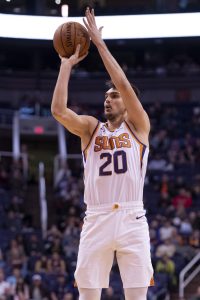The NBA’s rookie scale, which determines how much first round picks earn during their first four NBA seasons, also dictates how much the qualifying offers will be worth for those players once they’re eligible for restricted free agency after year four. However, the value of those qualifying offers can fluctuate depending on whether or not a player has met the “starter criteria.”
Here’s how the starter criteria works:
A player who is eligible for restricted free agency is considered to have met the starter criteria if he plays at least 2,000 minutes or starts 41 games in the season before he reaches free agency.
A player can also meet the criteria if he averages either of those marks in the two seasons prior to his restricted free agency. For instance, if a player started 50 games in 2018/19 and 32 in 2019/20, he’d meet the starter criteria, since his average number of starts over the last two seasons is 41.
A player’s ability or inability to meet the starter criteria impacts the value of the qualifying offer he receives as a restricted free agent, as follows:
- A top-14 pick who does not meet the starter criteria will receive a qualifying offer equal to the amount the 15th overall pick would receive if he signed for 120% of the rookie scale.
- Note: For the summer of 2020, the value of this QO will be $4,642,800.
- Example: Spurs center Jakob Poeltl (2016’s No. 9 overall pick) won’t meet the starter criteria this season. As a result, he’ll be eligible for a QO worth $4,642,800 instead of $5,087,871.
 A player picked between 10th and 30th who meets the criteria will receive a qualifying offer equal to the amount the ninth overall pick would receive if he signed for 120% of the rookie scale.
A player picked between 10th and 30th who meets the criteria will receive a qualifying offer equal to the amount the ninth overall pick would receive if he signed for 120% of the rookie scale.
- Note: For the summer of 2020, the value of this QO will be $5,087,871.
- Example: Suns forward Dario Saric (2014’s No. 12 overall pick, who signed his rookie scale contract in 2016) met the starter criteria by starting at least 41 games this season. As a result, he’ll be eligible for a QO worth $5,087,871 instead of $4,791,213.
- A second-round pick or undrafted player who meets the criteria will receive a qualifying offer equal to the amount the 21st overall pick would receive if he signed for 100% of the rookie scale.
- Note: For the summer of 2020, the value of this QO will be $3,126,948.
- Example: No second-round pick or undrafted player who can be an RFA this summer has met the starter criteria yet. In theory, players like Nuggets wing Torrey Craig (19 starts) and Pelicans forward Kenrich Williams (18 starts) could still get there.
- Note: For the summer of 2020, the value of this QO will be $3,126,948.
- For all other RFAs, the standard criteria determine the amounts of their qualifying offers.
Extending a qualifying offer to a player who is eligible for restricted free agency officially makes that player an RFA, ensuring that his team has the right of first refusal if he signs an offer sheet with another club. It also gives the player the option of signing that one-year QO.
Generally, the value of a restricted free agent’s qualifying offer isn’t hugely important, since very few RFAs accept those offers outright. There are exceptions though.
During the 2018 offseason, for instance, Rodney Hood accepted his qualifying offer, which was worth $3,472,888. Hood was nagged by injuries during the two seasons prior to his restricted free agency and was limited to just 119 total games, including 78 starts. If he had started four more games during that two-year stretch, he would have met the starter criteria and bumped the value of his QO up to $4,749,591, which could have changed the way his free agency played out.
We’ll revisit the starter criteria at season’s end to see which potential restricted free agents will have their qualifying offers impacted by meeting – or failing to meet – the starter criteria. So far, of this year’s RFAs-to-be, only Saric and Brandon Ingram have met it.
Note: This is a Hoops Rumors Glossary entry. Our glossary posts will explain specific rules relating to trades, free agency, or other aspects of the NBA’s Collective Bargaining Agreement. Information from Larry Coon’s Salary Cap FAQ and RealGM was used in the creation of this post.
An earlier version of this post was published in 2019 by Luke Adams.
Photo courtesy of USA Today Sports Images.
Nothing to do with this article but can we get Stephen A smith to fox sports so I never have to see him again please.